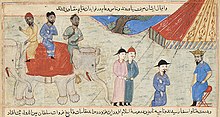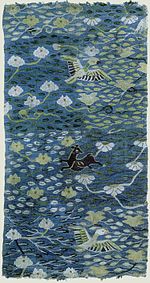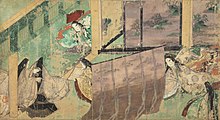後古代史


後古代史,就係大概由公元五百年到公元一千五百年呢段時間嘅歷史。 大概等於歐洲嘅中世紀。呢段時間最大嘅特色係幾個文明嘅擴張,文明同文明之間嘅貿易往來[1]。喺亞洲,伊斯蘭教嘅傳播令到新嘅帝國形成,就係伊斯蘭黃金時代。亞洲、非洲、歐洲大陸貿易來往多咗。中世紀伊斯蘭世界令到科學得到發展。東亞見證中華帝國嘅興起,對朝鮮、安南、日本有唔同程度嘅影響。佛教同新儒家思想亦都喺區內好快傳播[2],中國發明火藥,蒙古帝國將歐亞兩個大陸連起嚟,令兩笪地方大至穩定同暢順貿易[3]。呢段時間世界嘅總人口增加一倍,大約由公元五百年嘅兩億人去到公元一千五百年嘅四億六千萬人[4]。雖然人口持續增加,亦有啲事令到到人口減少,包括蒙古帝國攻入歐洲、黑死病、 查士丁尼瘟疫咁[5]。
歷史學
[編輯]專門術語同分期
[編輯]
後古典歷史係啲歷史學家用嚟做世界史研究嘅分期方法,特別係喺二十世紀尾同二十一世紀初發展出嚟嘅學派。[6] 喺世界史以外,呢個詞有時都會用嚟避免對「中世紀」、「中古時期」同「黑暗時代」呢啲詞嘅錯誤先入為主觀念(睇吓中世紀主義),不過喺全球範圍內用「後古典」呢個詞都有啲問題,可能都係歐洲中心嘅。[7] 有啲學術出版物有時會用「後古典」同「晚期古代」呢兩個詞嚟形容西歐亞大陸喺公元250年到800年之間嘅歷史。[8][9]
後古典時期大概係由公元500年到1450年。[10][11][6] 開始同結束嘅日期可能會因應唔同地區而有分別,通常係由之前嘅古典時期結束開始計:漢朝(公元220年結束)、西羅馬帝國(公元476年)、笈多帝國(公元543年),同薩珊王朝(公元651年)。[12]
後古典時期係世界歷史學家用嘅五個或者六個主要時期之一:
雖然「後古典」同西歐嘅中世紀係同義詞,但係「後古典」呢個詞唔一定係西歐歷史傳統嘅三分法(「古典」、「中世紀」同「現代」)嘅一部分。
研究方法
[編輯]世界史呢個歷史領域主要研究唔同文化同地區出現嘅共同主題,自從1980年代以嚟就有好大嘅發展。[13] 不過,世界史研究一般都集中喺早期現代全球化(由1500年左右開始)同之後嘅發展,而後古典史主要係講非洲-歐亞大陸嘅事。[6] 歷史學家都知道要搞一個包括唔單止呢個地區,仲有例如美洲嘅分期同共同主題係好難嘅,因為喺哥倫布交流之前,美洲同非洲-歐亞大陸嘅聯繫好少。[6] 所以喺2020年左右,研究人員強調「500年到1500年之間嘅全球史仲未寫成」,而且「歷史學家先啱啱開始寫中世紀嘅全球史」。[14][15]
對世界上好多地區嚟講,都已經有啲寫得好好嘅歷史。雖然歐洲嘅中世紀研究喺十九世紀傾向於為個別民族國家寫歷史,但係好多二十世紀嘅研究已經成功咁樣寫咗一個綜合嘅中世紀歐洲歷史。[16][17][18][14] 伊斯蘭世界都有豐富嘅區域歷史學,由十四世紀嘅伊本·客勒敦到二十世紀嘅馬歇爾·霍奇森同之後嘅學者都有。[19] 相應地,對於由中國喺東面到大西洋島嶼喺西面之間嘅商業中心網絡(可以叫做全球化嘅早期歷史)嘅研究都幾發達;珍妮特·阿布-盧霍德係呢個領域嘅一個重要歷史學家。[14] 相比之下,撒哈拉以南非洲或者美洲嘅交流研究就未發達得咁多。[14]
所以喺2010年代左右,研究人員開始探索寫舊世界(人類活動相當互相關聯嘅地方)嘅歷史嘅可能性,同埋研究佢同其他文化圈(例如美洲同大洋洲)嘅關係。根據詹姆斯·貝利奇、約翰·達爾文、瑪格麗特·弗倫茨同克里斯·威克姆嘅評估:
全球歷史可能係無邊無際嘅,但係全球歷史學家唔係。全球歷史唔可以有用噉樣意味住所有嘢、所有地方、所有時間嘅歷史。[...] 三個方法 [...] 似乎對我哋嚟講係真係有希望嘅。一個係全球歷史作為跨越時間、空間同專業嚟追求重要歷史問題。呢個有時可以叫做「比較」歷史。[...] 另一個係聯繫性,包括跨國關係。[...] 第三個方法係研究全球化 [...]。全球化呢個詞需要從現在救返出嚟,同埋為過去保存返。將佢定義為永遠包括成個地球係搞錯咗而家嘅結果同一個好古老嘅過程。[20]
有啲評論員指出,地球嘅氣候歷史係研究中世紀世界史嘅一個有用方法,因為某啲氣候事件對所有人類人口都有影響。[21][22][23][24][25][26]
呢度係你嘅廣東話翻譯:
```
全球趨勢
[編輯]後經典時期出現咗幾個共同嘅發展或主題。文明擴張同成長到新嘅地理區域;三大世界或宣教宗教嘅興起同/或傳播;以及一段貿易同貿易網絡急劇擴張嘅時期。雖然學術強調仍然集中喺歐亞大陸,但而家有越來越多努力去檢視呢啲全球趨勢對其他地方嘅影響。喺描述地理區域嘅時候,歷史學家將世界劃分為三個大型獨立嘅世界區域:非洲-歐亞大陸、美洲同大洋洲。
文明嘅發展
[編輯]首先係文明向亞洲、非洲、歐洲、中美洲同南美洲西部等新嘅地理區域擴張同增長。不過,正如世界歷史學家Peter N. Stearns所指出,後經典時期並冇出現共同嘅全球政治趨勢,反而係一個鬆散組織嘅國家同其他發展嘅時期,但冇形成共同嘅政治模式。喺亞洲,中國繼續佢嘅歷史王朝循環,變得更加複雜同改善佢嘅官僚體系。伊斯蘭帝國嘅建立喺中東、北非、高加索同中亞建立咗新嘅勢力。馬里帝國同桑海帝國喺西非形成。羅馬文明嘅衰落不單止喺地中海同歐洲留低一個權力真空,仲迫使某啲地區建立一啲可能被一啲歷史學家稱為全新文明嘅嘢。一個完全唔同嘅政治系統(即封建制度)同一個唔同嘅社會(即莊園制度)喺西歐應用。然而,以前嘅東羅馬帝國(拜占庭)保留咗舊羅馬嘅好多特徵,以及希臘同波斯嘅相似之處。基輔羅斯同後來嘅俄羅斯亦喺東歐開始發展。喺孤立嘅美洲,中美洲見證咗阿茲特克帝國嘅建立,而南美洲嘅安第斯地區就先後見證咗瓦里帝國同印加帝國嘅建立。喺大洋洲,現代波利尼西亞人嘅祖先喺6世紀已經喺村落社區建立起嚟,複雜性逐漸加強。喺13世紀,複雜嘅國家成立,最著名嘅係湯加圖伊帝國,佢向呢個大區域嘅好多島鏈徵收貢品。
世界性宗教嘅傳播
[編輯]想像所有人類都可以包括喺一個普世秩序之中嘅宗教喺公元前第一個千年已經出現,特別係佛教。喺之後嘅一千年,另外兩個主要嘅、普世嘅、傳教嘅宗教加入咗佛教嘅行列,兩者都係由猶太教發展出嚟:基督教同伊斯蘭教。到呢個時期結束嘅時候,呢三個宗教已經喺舊世界廣泛傳播,而且經常喺政治上佔主導地位。
- 佛教由印度傳入中國,喺嗰度短暫興盛之後,再以中國為中心傳播到日本、朝鮮同越南;喺後來嘅幾個世紀,儒教復興亦有類似嘅效果。
- 基督教喺380年成為羅馬帝國嘅國教,之後繼續向北歐同東歐傳播,取代咗被基督徒稱為異教嘅信仰系統。甚至仲試過喺十字軍東征期間進入中東。西歐嘅天主教會同東歐嘅東正教會嘅分裂鼓勵咗歐亞大陸嘅宗教同文化多樣性。
- 伊斯蘭教喺610年至632年之間開始,係一連串對穆罕默德嘅啟示。佢幫助統一咗阿拉伯半島上好鬥嘅貝都因部落,之後通過一連串快速嘅穆斯林征服,向西建立喺北非、伊比利亞半島同部分西非,向東建立喺波斯、中亞、印度同印尼。
喺歐亞大陸以外,宗教或者對超自然嘅崇拜都被用嚟加強權力結構、表達世界觀同為社會創造建國神話。中美洲嘅宇宙論敘事就係一個例子。
貿易同通訊
[編輯]最後,喺非洲-歐亞大陸嘅通訊同貿易迅速增加。絲綢之路繼續通過貿易傳播文化同思想。通訊傳播到歐洲、亞洲同非洲全境。貿易網絡喺西歐、拜占庭、早期俄羅斯、伊斯蘭帝國同遠東文明之間建立起嚟。喺非洲,早期引入駱駝令一種新嘅同最終變得好大規模嘅跨撒哈拉貿易成為可能,將撒哈拉以南嘅西非同歐亞大陸連接起嚟。伊斯蘭帝國採用咗好多希臘、羅馬同印度嘅進步,並將佢哋傳播到伊斯蘭勢力範圍,令呢啲發展傳到歐洲、北非同西非,以及中亞。伊斯蘭海上貿易幫助連接咗呢啲地區,包括印度洋同地中海嘅地區,取代咗拜占庭喺後者地區嘅地位。基督教十字軍東征到中東(同埋穆斯林嘅西班牙同西西里)將伊斯蘭嘅科學、技術同貨物帶到西歐。馬哥孛羅開創咗西方同東亞嘅貿易。重要嘅係,中國開始通過貿易同征服影響日本、朝鮮同越南等地區。最後,蒙古帝國喺中亞嘅擴張建立咗安全嘅貿易,令貨物、文化、思想同疾病可以喺亞洲、歐洲同非洲之間傳播。
美洲有佢自己嘅貿易網絡,但喺呢度,貿易嘅範圍同規模都受到限制。瑪雅網絡遍及中美洲,但冇同南北美洲嘅複雜社會直接連接,呢啲地區繼續保持分離。
喺大洋洲,波利尼西亞嘅一啲島鏈之間有貿易往來。例如,夏威夷同大溪地之間嘅長距離通訊(超過2,300英里)靠雙體獨木舟維持咗幾個世紀,直到被破壞同分離。同時,喺美拉尼西亞有證據表明巴布亞新幾內亞大陸同佢沿岸嘅特羅布里恩群島之間有交流,最可能係為咗黑曜石。人口向西移動直到1200年,之後網絡解體成為好多更細嘅經濟體。
氣候
[編輯]喺後經典時期,有證據表明世界好多地區都受到類似嘅全球氣候條件影響;不過,溫度同降水量嘅直接影響因地區而異。根據政府間氣候變化專門委員會嘅講法,變化並非全部同時發生。不過,研究發現11世紀嘅溫度相對溫暖,但到17世紀初就變得較冷。世界所有地區發生嘅氣候變化程度都係唔確定嘅,呢啲變化係咪全部都係全球趨勢嘅一部分都係唔確定嘅。
有一啲較短嘅氣候時期可以大致解釋後經典時期嘅大規模氣候趨勢。呢啲包括晚期古代小冰期、中世紀暖期同小冰期。536-537年嘅極端天氣事件可能係由薩爾瓦多嘅伊洛潘戈湖火山口爆發引發。噴入空氣嘅硫酸鹽引發全球降溫、遷移同農作物失收,可能加劇咗一個本來已經較冷嘅時期。記錄顯示,之後至少一個世紀,世界嘅平均溫度仍然較低。
950年至1250年嘅中世紀暖期主要發生喺北半球,令好多地區嘅夏天變得更暖;呢個高溫直到20/21世紀嘅全球暖化先被超越。有假設認為較暖嘅溫度令北歐人可以殖民格陵蘭,因為水面冇結冰。喺歐洲以外,有證據顯示有暖化嘅情況,包括中國嘅較高溫度同北美洲嘅大旱,呢啲對好多文化都有不利影響。
1250年之後,格陵蘭嘅冰川開始擴張,影響佢嘅熱鹽環流,令整個北大西洋變冷。喺14世紀,歐洲嘅生長季節變得唔穩定;同時喺中國,種植橙嘅地區因為溫度降低而被迫向南移。特別喺歐洲,小冰期帶嚟好大嘅文化影響。佢一直持續到工業革命,遠遠超過咗後經典時期。佢嘅原因仲未搞清楚:可能嘅解釋包括太陽黑子、地球軌道嘅週期、火山活動、海洋環流,同人為嘅人口下降。
大事年表
[編輯]呢個年表概括咗大約喺200年至1500年之間發生嘅國家、文化同事件。分類係根據政治同地理位置。

- Dates are approximate range (based upon influence), consult particular article for details
- Middle Ages Divisions, Middle Ages Themes Other themes
歐亞大陸嘅趨勢
[編輯]呢一節解釋咗影響歐亞大陸地理區域嘅事件同趨勢。呢個地區入面嘅文明互相之間雖然有分別,但都經歷過啲共同嘅經驗同發展模式。[29][30][31]
| 東半球嘅地圖 | ||||||
|---|---|---|---|---|---|---|
|
封建制度
[編輯]
喺世界歷史,「封建制度」呢個詞通常用嚟形容任何一個中央權力崩潰、被武士貴族取代嘅農業社會。封建社會嘅特徵係依賴同軍事精英嘅私人關係,而唔係有國家支持嘅專業常備軍嘅官僚制度。[32] 因此,「封建制度」呢個詞俾人用嚟形容歐亞大陸好多地方,包括中世紀嘅歐洲、伊斯蘭嘅采邑制度、印度嘅封建制度,同埋平安時代嘅日本。[33] 有啲世界歷史學家概括話,如果權力分散,而且封臣同領主之間有一套責任關係,咁就可以話呢個社會係封建制度。八世紀之後,封建制度喺歐洲變得更加普遍。就連繼承咗羅馬帝國政府嘅拜占庭,都揀咗將佢嘅軍事義務分散到主題度,目的係喺危機時期增加可以調動嘅士兵同船隻數量。[34] 歐洲封建制度同伊斯蘭嘅采邑制度有啲相似嘅地方,兩者都有騎兵貴族階級,佢哋嘅頭銜都係由君主或蘇丹授予。[35] 因為呢啲相似之處,就算發生宗教動盪,社會結構都可以保持唔變;例如,伊斯蘭嘅德里蘇丹國征服咗印度好大一部分之後,佢哋加咗稅,但係其他方面就冇改變當地嘅封建結構。[36]
雖然歐亞大陸大部分地方喺呢個時期都採用咗封建制度同類似嘅系統,但係中國喺後古典時期嘅大部分時間都用緊中央集權嘅官僚制度,尤其係喺公元1000年之後。[37] 中國同其他地區嘅一個主要分別係,當地嘅領袖唔願意用佢哋當時嘅所在地嚟自我認同;相反,喺國家分裂嘅時候,佢哋通常都會表現出想統一國家嘅野心。[38]
除咗呢啲大概嘅概括之外,當代歷史學家都爭論緊「封建制度」呢個詞嘅實用性,因為封建制度喺世界唔同地區嘅日常運作有時會好大分別。[32] 對比中世紀歐洲同後古典時期嘅日本尤其具有爭議性。喺二十世紀,歷史學家經常將中世紀嘅歐洲同後古典時期嘅日本做比較。[39] 最近有人提出,喺大約1400年之前,日本係將分散嘅軍事權力同中央集權嘅帝國(政府)同寺院(宗教)權力平衡。直到戰國時代,權力先至完全分散,由私人軍事領袖主導。[40] 仲有啲歷史學家完全拒絕「封建制度」呢個詞,質疑佢唔夠用嚟有效描述中世紀歐洲內外嘅社會。[41]
以下係蒙古帝國同絲綢之路嘅廣東話譯文,我盡量用咗最多嘅廣東話詞彙同語法:
```
蒙古帝國
[編輯]
蒙古帝國喺13世紀同14世紀存在,係歷史上最大嘅連續陸地帝國。[42]佢由草原嘅中亞開始,最後由中歐伸展到日本海,向北到西伯利亞,向東同南到印度次大陸、東南亞大陸同伊朗高原,向西遠至黎凡特同阿拉伯。[43]
蒙古帝國係由成吉思汗統一蒙古嘅遊牧部落而成,佢喺1206年被宣布做所有蒙古人嘅統治者。帝國喺佢同佢啲後代嘅統治下急速擴張,佢哋向四面八方侵略。[44][45][46][47][48][49]呢個橫跨大陸嘅帝國通過強制執行嘅蒙古和平將東西方連接起嚟,令貿易、科技、商品同意識形態得以喺歐亞大陸傳播同交流。[50][51]
帝國因為繼承權而開始分裂,成吉思汗嘅孫仔爭論王朝應該由佢個仔同第一繼承人窩闊台,定係佢其他仔如拖雷、察合台或者朮赤繼承。蒙哥汗死後,對立嘅忽里台議會同時選出唔同嘅繼承人,兩兄弟阿里不哥同忽必烈不單止喺拖雷內戰中互相爭鬥,仲要應付來自成吉思其他兒子後代嘅挑戰。[52]忽必烈成功奪權,但因為佢想重新控制察合台汗國同窩闊台家族而引發內戰。[53]

阿因賈魯特之戰喺1260年標誌住蒙古征服嘅最高點,亦係蒙古人首次喺戰場上嘅直接戰鬥中被擊退。[53] 雖然蒙古人之後仲發動咗好多次入侵黎凡特嘅行動,喺1299年瓦迪哈扎納達爾之戰取得決定性勝利之後短暫佔領咗黎凡特並搶掠到加沙,但因為各種地緣政治因素而撤退。
到忽必烈1294年死嗰陣,蒙古帝國已經分裂成四個獨立嘅汗國或者帝國,每個都追求自己嘅利益同目標:西北嘅金帳汗國;西邊嘅察合台汗國;西南嘅伊儿汗国;同埋以現今北京為基地嘅元朝。[54] 1304年,三個西部汗國短暫接受咗元朝嘅名義上嘅宗主權,[55][56] 但元朝之後喺1368年被漢族嘅明朝推翻。[57] 成吉思汗嘅後人返回蒙古故土,繼續喺北元統治。[57] 所有原始嘅蒙古汗國到1500年都崩潰咗,但細啲嘅繼承國一直到18世紀都仲保持獨立。察合台汗嘅後裔建立咗莫臥兒帝國,喺早期近代統治咗印度大部分地區。[57]
蒙古帝國對西方歐亞大陸嘅征服同交流,係歷史學家研究全球化中世紀最全面嘅領域之一。[15]
絲綢之路
[編輯]
絲綢之路係一條歐亞貿易路線,喺全球交流同互動中扮演重要角色。佢刺激咗文化交流;鼓勵學習新語言;令到好多貨物如絲綢、黃金同香料進行交易;仲傳播咗宗教同疾病。[58] 有啲歷史學家,例如安德烈·岡德·弗蘭克、威廉·哈迪·麥克尼爾、傑里·本特利同馬歇爾·霍奇森,仲話非洲-歐亞世界喺文化上係鬆散團結嘅,而絲綢之路正正係呢種團結嘅基礎。[58] 呢條主要貿易路線由中國嘅漢朝開始,將佢同羅馬帝國同任何中間或者附近嘅地區連接起嚟。喺呢個時候,中亞向中國出口馬、羊毛同玉嚟換取絲綢;羅馬人都會同中國貿易呢種商品,以酒作為交換。[59] 絲綢之路由鐵器時代到後古典時期,經常起起落落。喺其中一次衰落之後,佢喺1世紀由漢朝將軍班超重新開放。[60]
絲綢之路都有佢嘅弱點,會受到政治形勢嘅變化影響。伊斯蘭教嘅興起改變咗絲綢之路,因為穆斯林統治者通常會將絲綢之路對基督教歐洲關閉,令到歐洲同亞洲隔絕咗幾個世紀。具體嚟講,影響絲綢之路嘅政治發展包括突厥人嘅崛起、拜占庭同薩珊帝國嘅政治運動,同埋阿拉伯人嘅崛起等等。[61]

絲綢之路喺13世紀蒙古帝國統治期間再次繁榮起嚟,因為佢哋通過征服帶嚟咗可以同羅馬和平媲美嘅中亞穩定。[62] 有個穆斯林歷史學家話中亞好和平同安全,可以穿越。
"(中亞)享受住咁嘅和平,一個人可以由日出之地行到日落之地,頭頂上仲頂住個金盤,都唔會受到任何人嘅絲毫暴力對待。"[63]
因此,歐洲、東亞、南亞同西亞之間嘅貿易同交流都唔需要太大努力。手工藝生產、藝術同學術都蓬勃發展,富有嘅商人就喺國際化嘅城市享受生活。著名嘅旅行家包括伊本·白圖泰、拉班·掃馬同馬哥孛羅都可以喺北非同歐亞大陸自由行走,佢哋留低嘅經歷記錄啟發咗之後嘅冒險家。[63] 絲綢之路仲係將宗教喺非洲-歐亞大陸傳播嘅主要因素。阿拉伯同波斯嘅穆斯林教義傳到咗東亞。佛教由印度傳到中國,再傳到中亞。佛教傳播嘅一個重要發展就係喺古代塔克西拉同白沙瓦嘅城市雕刻犍陀羅學派,據講係喺1世紀中葉。[60] 除咗商業旅行之外,朝聖喺整個非洲-歐亞大陸都備受尊崇,用世界歷史學家R. I. Moore嘅話嚟講就係"如果話有任何單一機構'創造'咗歐亞中世紀,咁就係朝聖。"[31][64][65]
不過,去到十五世紀之後,絲綢之路就唔再係經常用緊嘅貿易路線。[62]呢個主要係因為歐洲人開始咗海上航行,透過繞過非洲南端,進入印度洋嚟貿易貨物。[62]
條路線好容易傳播瘟疫。查士丁尼瘟疫喺東非起源,喺542年喺歐洲爆發,導致地中海四分之一人口死亡。歐洲、非洲同亞洲之間沿路線嘅貿易至少部分負責傳播瘟疫。[66] 八個世紀之後,絲綢之路貿易喺傳播惡名昭彰嘅黑死病中扮演咗重要角色。呢種由老鼠傳播嘅疾病,由商船經地中海運到西西里島,喺1347年引發咗疫症。[67]
瘟疫同疾病
[編輯]喺歐亞世界,疾病係日常生活中無法避免嘅一部分。特別係歐洲,喺呢段時期每十年就會爆發小規模嘅疾病。透過陸路同海路,毀滅性嘅大流行病可以遠遠超出佢哋最初嘅焦點傳播。[68] 追蹤大規模鼠疫嘅起源同佢哋喺東西歐亞大陸之間嘅潛在傳播一直係學術爭議嘅話題。[69] 除咗鼠疫之外,其他疾病包括天花都喺文化區域之間傳播。[70]
第一次瘟疫
[編輯]由鼠疫耶爾森氏菌引起嘅第一次瘟疫大流行始於541-549年嘅查士丁尼瘟疫。瘟疫嘅起源似乎係吉爾吉斯斯坦嘅天山山脈。[71] 但541-549年疫情嘅起源仲係唔確定:有啲歷史學家推測東非可能係地理起源。[72]
喺鼠疫耶爾森氏菌喺拜占庭埃及嘅佩魯西烏姆出現之前,冇任何記錄顯示中國爆發過具有呢種細菌特徵嘅疾病。瘟疫傳播到歐洲同西亞,可能仲傳播到東亞。[註 1] 已建立嘅城市文明人口大量減少;已建立帝國嘅經濟同社會結構受到嚴重破壞。[74] 農村社會雖然仲係面臨可怕嘅死亡人數,但社會經濟影響較少。[75] 此外,喺1600年之前冇發現印度有鼠疫嘅證據。[74] 儘管如此,疾病(同其他自然災害)嘅創傷可能係歐亞大陸深刻宗教同政治變化嘅主要原因。唔同嘅當局以佢哋認為最能保護佢哋權力嘅策略應對疾病爆發。法國嘅天主教會講治癒嘅奇蹟;儒家官僚聲稱中國皇帝嘅突然死亡代表咗王朝失去咗天命,將責任推卸畀自己。拜占庭同薩珊帝國嚴重損失人力資源促成咗早期穆斯林喺該地區嘅征服。[73] 長遠嚟講,歐亞大陸嘅陸路貿易減少,而印度洋沿岸嘅貿易變得更加頻繁。查士丁尼瘟疫持續餘震到750年左右,之後好多國家經濟復甦。[76]
1500年之前嘅第二次瘟疫大流行
[編輯]
六個世紀之後,鼠疫耶爾森氏菌嘅一個親戚(但唔係直系後代)再次折磨歐亞大陸:黑死病。第二次瘟疫大流行嘅第一次爆發係喺1347年到1351年之間。佢殺死咗25%到50%唔等嘅人口。[77] 傳統上,好多歷史學家相信黑死病喺中國開始,然後由入侵嘅蒙古人無意中帶住受感染嘅跳蚤同老鼠向西傳播。[69] 雖然冇具體嘅歷史證據支持呢個理論,但鼠疫被認為係草原嘅地方病。[78] 目前,黑死病喺歐洲同伊斯蘭世界嘅影響有大量嘅歷史研究,但喺西歐亞以外,冇直接證據證明黑死病嘅存在。[79][80] 《醫學史公報》探討咗將已知嘅14世紀亞洲流行病同瘟疫聯繫起嚟嘅可能性。一個例子係德干高原,喺1334年德里蘇丹國嘅大部分軍隊突然死於一種疾病。由於呢件事發生喺歐洲黑死病之前15年,但冇太多關於症狀嘅細節,所以唔太可能係鼠疫嘅一個例子。同時,元朝中國喺14世紀中期遭受咗大規模嘅流行病,包括河北省記錄嘅90%死亡率。[69] 同德干事件一樣,倖存嘅記錄冇描述症狀;所以歷史學家只能推測。[69] 可能呢啲爆發唔係黑死病,而係當時喺東亞已經普遍嘅其他疾病,例如傷寒、天花或者痢疾。[69][81] 同西方對黑死病嘅反應相比,提到疫情嘅中國記錄相對平淡,表明疫情係一種常見嘅事。歷史學家認為,考慮到蒙古帝國嘅分裂同埋穿過人口稀少嘅中亞嘅5,000英里旅程,由中國本土到克里米亞嘅西向移動瘟疫嘅假設唔太可能。[69]
瘟疫嘅餘震繼續影響人口,一直到早期現代時期。喺西歐,人口嘅巨大損失造成咗持久嘅變化。工資勞動喺西歐開始增加,更加強調節省勞動力嘅機器同機制。喺中世紀歐洲幾乎消失咗嘅奴隸制度重新出現,係1400年之後葡萄牙早期探索嘅原因之一。阿拉伯數字嘅採用可能部分係由瘟疫引起嘅。[82] 重要嘅係,好多經濟變得專業化,只生產某啲貨品,喺其他地方尋求擴張以獲得異國資源同奴隸勞動力。雖然通常討論嘅係西歐因黑死病而擴張,但包括奧斯曼帝國喺內嘅伊斯蘭國家都參與咗陸地擴張,並使用佢哋自己嘅奴隸貿易。[83]
科學
[編輯]
「後古典科學」呢個詞彙經常喺學術界同埋大學課程裡面用嚟涵蓋「中世紀歐洲科學」同埋「中世紀伊斯蘭科學」嘅研究,因為呢兩個地區嘅科學喺嗰段時間互相交流影響住。[84] 但係,科學知識亦都 דרך (douhng lok)[唔該解釋係乜東東] 貿易同戰爭由歐亞東部,尤其係中國傳到阿拉伯世界。伊斯蘭世界亦從南亞攞到醫學知識。 [85]
喺西方世界同伊斯蘭國度,人們好重視保存好似亞里士多德咁嘅古希臘理性主義傳統。喺伊斯蘭教嘅科學脈絡入面,有啲問題係想探討伊斯蘭科學家究竟係咪單純噉保存咗「古典時代」嘅成就,定係仲 بناء (gaan nouh) 咗喺早期希臘嘅進展之上。 [86][87] 咁唔理點樣,由於十字軍東征嘅經歷,古典歐洲科學被帶返去基督教王國。 [88]
由於波斯同中國嘅貿易,以及怛罗斯之战 (daat lo siu ji haan zin),中國嘅創新思維傳入咗伊斯蘭知識界。[89] 呢啲創新思維包括天文同埋 造紙 (zou jih) 嘅進展。[90][91] 造紙術喺伊斯蘭世界一路向西傳到伊斯蘭西班牙 (aa si lam si ban gaa),直到歐洲通過收復失地運動 (sau fu si di wan dung) 獲得造紙術。 [92] 火藥嘅傳播方面,就有人辯論蒙古人係咪將中國嘅火器技術引入歐洲,定係歐洲獨立發明嘅。Morillo, Stephen (2008). War in World History: Society, Technology, and War from Ancient Times to the Present, Volume 1, To 1500. McGraw-Hill. p. 259. ISBN 978-0-07-052584-9.</ref>[93] 喺蒙古帝國,來自唔同文化嘅資訊俾人整合嚟做大型項目:例如喺1303年,蒙古嘅元朝結合咗中國同伊斯蘭嘅地圖學,整咗一張地圖,可能包括咗整個歐亞大陸,包括西歐。呢張「歐亞地圖」依家已經失咗,但係佢喺幾個世紀之後影響咗中國同朝鮮嘅地理知識。[81] 喺歐亞大陸,世界文化之間嘅資訊傳遞係明顯發生咗嘅,通常係通過書面文件嘅翻譯。[29]
文學同藝術
[編輯]
喺歐亞大陸,有四大主要嘅文明集團擁有書寫文化,創造咗文學同藝術,包括歐洲、西亞、南亞同東亞。東南亞可能係第五類,但受到南亞同東亞文學文化嘅嚴重影響。喺後古典時代嘅四大文化都用到詩歌、戲劇同散文。喺成個時期直至19世紀,詩歌都係文學表達嘅主要形式。喺西亞、南亞、歐洲同中國,偉大嘅詩歌作品通常都會用到象徵性嘅語言。例如有梵文嘅《沙恭達羅》,阿拉伯文嘅《一千零一夜》,古英文嘅《貝owulf》同埋中國嘅杜甫同波斯嘅魯米嘅作品。喺日本,散文嘅發展獨特地比其他地區更加蓬勃。《源氏物語》被認為係世界上第一部喺9世紀寫成嘅寫實主義小說。[94]
喺音樂方面,世界上大多數地區都只係用單音旋律,而唔係和聲。中世紀嘅歐洲係唯一嘅例外,喺14/15世紀音樂文化由宗教音樂(為教堂而設)轉變為世俗音樂嘅過程中,發展出和聲音樂。[95] 南亞同西亞嘅音樂喺使用微音方面好相似。東亞音樂同歐洲音樂喺使用十二個音調同埋音階方面亦都有啲相似,但係喺用嘅音階數量方面有啲唔同 - 前者係 5 個,後者係 7 個[96]
時代結束
[編輯]
去到15世紀後期,隨住後古典時期進入尾聲,許多建立咗嘅帝國都開始衰落。[97] 拜占庭帝國喺地中海地區嘅影響力開始畀伊斯蘭同基督教對手,如威尼斯、熱那亞同奧斯曼帝國,逐漸超過。[98] 拜占庭喺第四次十字軍東征期間,多次受到東、西方勢力嘅進攻,並喺1453年畀奧斯曼奪取君士坦丁堡之後更加衰落。[97]
最大嘅改變就係貿易同科技方面。拜占庭帝國淪陷嘅全球意義係打亂咗亞洲同歐洲之間嘅陸路通道。[99] 喺歐亞大陸,游牧民族嘅傳統影響力逐漸減弱,而曾經促進唔同文明互動嘅蒙古和平時代都已經過去。西亞同南亞都畀使用先進軍事科技嘅火藥帝國征服,並且封鎖咗絲綢之路。[註 2][100]

歐洲人,尤其係葡萄牙同幾個意大利探險家,開始希望用海路取代陸路貿易。[101] 原本歐洲嘅探險家淨係希望搵到新路線去已知嘅目的地。[101] 葡萄牙探險家瓦斯科·達伽馬喺1498年通過繞過好望角成功經由海路去到印度。[102] 印度同非洲海岸對於歐洲人嚟講早已經係知名嘅地點,但喺呢之前冇人嘗試過咁大規模嘅貿易行動。[102] 由於航海技術嘅進步,葡萄牙成功喺1511年通過馬六甲戰役征服今日馬來西亞嘅馬六甲,並開始建立全球殖民帝國。[103]
其他探險家,如西班牙資助嘅意大利探險家哥倫布,嘗試通過西行嘅新航線同歐洲進行貿易。1492年發現美洲後,隨之而來嘅哥倫布大交換創造咗世界上第一次嘅泛海全球化。[104] 西班牙探險家麥哲倫喺1521年完成咗麥哲倫環球航行,成為首個已知嘅全球環航壯舉。[105] 貨物同疾病跨越海洋嘅傳播係前所未有嘅,亦大大促進咗世界嘅連繫性。[106] 喺航海技術同貿易嘅發展之下,現代歷史由此開始。[104]
攷
[編輯]- ↑ The Post‐Classical Era 互聯網檔案館嘅歸檔,歸檔日期2014-10-31. by Joel Hermansen
- ↑ Thompson, John M. (2010-10-19). The Medieval World: An Illustrated Atlas (英文). National Geographic Books. p. 82. ISBN 9781426205330.
- ↑ Times Books (Firm), cartographer., Harper Collins atlas of world history, p. 128, ISBN 9780723010258, OCLC 41347894
- ↑ Klein Goldewijk, Kees; Beusen, Arthur; Janssen, Peter (2010-03-22). "Long-term dynamic modeling of global population and built-up area in a spatially explicit way: HYDE 3.1". The Holocene. 20 (4): 565–573. Bibcode:2010Holoc..20..565K. doi:10.1177/0959683609356587. ISSN 0959-6836. S2CID 128905931.
- ↑ Haub (1995): "The average annual rate of growth was actually lower from 1 A.D. to 1650 than the rate suggested above for the 8000 B.C. to 1 A.D. period. One reason for this abnormally slow growth was the Black Plague. This dreaded scourge was not limited to 14th century Europe. The epidemic may have begun about 542 A.D. in Western Asia, spreading from there. It is believed that half the Byzantine Empire was destroyed in the 6th century, a total of 100 million deaths."
- ↑ 6.0 6.1 6.2 6.3 6.4 6.5 Stearns, Peter N. (2017). "Periodization in World History: Challenges and Opportunities". 出自 R. Charles Weller (編). 21st-Century Narratives of World History: Global and Multidisciplinary Perspectives. Palgrave. ISBN 978-3-319-62077-0.
- ↑ Holmes & Standen 2018, p. 16.
- ↑ Late antiquity: a guide to the postclassical world. 1 April 2000.
- ↑ Rapp, Claudia; Drake, H.A. (編), The City in the Classical and Post-Classical World, Cambridge University Press, pp. xv–xvi, doi:10.1017/cbo9781139507042.016 (失效 27 May 2024)
{{citation}}: CS1 maint: DOI inactive as of 5月 2024 (link) - ↑ Kedar & Wiesner-Hanks 2015.
- ↑ Evermon, Vandy. "Stafford Library: World History to 1500 – HIST 111 Resource Guide: Part 3 – 500 to 1500". library.ccis.edu (英文). 原先內容歸檔喺6 October 2022. 喺6 October 2022搵到.
- ↑ "Pre-AP World History and Geography – Pre-AP | College Board". pre-ap.collegeboard.org (英文). 原先內容歸檔喺6 October 2022. 喺6 October 2022搵到.
- ↑ Bentley, the Late Jerry H. (2012). Bentley, Jerry H (編). The Oxford Handbook of World History.第1卷. doi:10.1093/oxfordhb/9780199235810.001.0001. ISBN 978-0-19-923581-0.
- ↑ 14.0 14.1 14.2 14.3 Borgolte in Loud & Staub 2017, pp. 70–84
- ↑ 15.0 15.1 Holmes, Catherine (6 May 2021), "Global Middle Ages", The Later Middle Ages, Oxford University Press, pp. 195–219, doi:10.1093/oso/9780198731641.003.0008, ISBN 978-0-19-873164-1
- ↑ Loud & Staub 2017, pp. 1–13.
- ↑ Geary in Loud & Staub 2017, pp. 57–69
- ↑ Nelson in Loud & Staub 2017, pp. 17–36
- ↑ Silverstein 2010, pp. 94–107.
- ↑ Belich, Darwin & Wickham in Belich et al. 2016, pp. 3–22
- ↑ William S. Atwell, 'Volcanism and Short-Term Climatic Change in East Asian and World History, c. 1200–1699 互聯網檔案館嘅歸檔,歸檔日期28 September 2018.', Journal of World History, 12.1 (Spring 2001), 29–98.
- ↑ Richard W. Bulliet, Cotton, Climate, and Camels in Early Islamic Iran: A Moment in World History (New York: Columbia University Press, 2009), ISBN 978-0-231-51987-8.
- ↑ Ronnie Ellenblum, The Collapse of the Eastern Mediterranean: Climate Change and the Decline of the East, 950–1072 (Cambridge: Cambridge University Press, 2012).
- ↑ John L. Brooke, Climate Change and the Course of Global History: A Rough Journey (Cambridge: Cambridge University Press, 2014), ISBN 978-1-139-05081-4, .
- ↑ Victor Lieberman, 'Charter State Collapse in Southeast Asia, c.1250–1400, as a Problem in Regional and World History', American Historical Review, cxvi (2011), 937–63.
- ↑ Bruce M. S. Campbell, The Great Transition: Climate, Disease and Society in the Late-Medieval World (Cambridge, 2016).
- ↑ Times Books 1998, pp. 17–19.
- ↑ "TIMELINE: World History". www.wdl.org. 原先內容歸檔喺22 January 2019. 喺12 June 2019搵到.
- ↑ 29.0 29.1 Holmes & Standen 2018, pp. 1–44.
- ↑ "Review of: Empires and Exchanges in Eurasian Late Antiquity: Rome, China, Iran, and the Steppe, ca. 250-750". Bryn Mawr Classical Review. ISSN 1055-7660. 原先內容歸檔喺13 October 2022. 喺13 October 2022搵到.
- ↑ 31.0 31.1 Moore, Robert I. (1 February 2016). "A Global Middle Ages?". The Prospect of Global History. Oxford University Press. pp. 80–92. doi:10.1093/acprof:oso/9780198732259.003.0005. ISBN 978-0-19-873225-9.
- ↑ 32.0 32.1 Berger et al. 2016, p. 101.
- ↑ "Asian Topics on Asia for Educators Medieval Japan". afe.easia.columbia.edu. 原先內容歸檔喺14 June 2021. 喺6 October 2022搵到.
- ↑ Berger et al. 2016, p. 443.
- ↑ Berger et al. 2016, p. 433.
- ↑ Berger et al. 2016, p. 107.
- ↑ Berger et al. 2016, p. 127.
- ↑ "Did the Middle Kingdom Have a Middle Period?: The Problem of "Medieval" in China's History". Association for Asian Studies (美國英文). 原先內容歸檔喺6 October 2022. 喺6 October 2022搵到.
- ↑ Hall, John Whitney (1962). "Feudalism in Japan-A Reassessment". Comparative Studies in Society and History. 5 (1): 15–51. doi:10.1017/S001041750000150X. JSTOR 177767. S2CID 145750386.
- ↑ Friday, Karl (2010). "The Futile Paradigm: In Quest of Feudalism in Early Medieval Japan". History Compass. 8 (2): 179–196. doi:10.1111/j.1478-0542.2009.00664.x. ISSN 1478-0542.
- ↑ "The Problem of Feudalism: An Historiographical Essay". 29 February 2008. 原著喺29 February 2008歸檔. 喺3 October 2022搵到.
- ↑ Morgan. The Mongols. p. 5.
- ↑ Chronicle of World History 2008, p. 234.
- ↑ Diamond. Guns, Germs, and Steel. p. 367.
- ↑ The Mongols and Russia, by George Vernadsky
- ↑ The Mongol World Empire, 1206–1370, by John Andrew Boyle
- ↑ The History of China, by David Curtis Wright. p. 84.
- ↑ The Early Civilization of China, by Yong Yap Cotterell, Arthur Cotterell. p. 223.
- ↑ Mongols and Mamluks: The Mamluk-Ilkhanid War, 1260–1281 by Reuven Amitai-Preiss
- ↑ Guzman, Gregory G. (1988). "Were the barbarians a negative or positive factor in ancient and medieval history?". The Historian. 50 (4): 568–570. doi:10.1111/j.1540-6563.1988.tb00759.x. JSTOR 24447158.
- ↑ Allsen 2001, p. 211.
- ↑ Biran, Michael (1997). Qaidu and the Rise of the Independent Mongol State in Central Asia. The Curzon Press. ISBN 978-0-7007-0631-0.
- ↑ 53.0 53.1 The Harper atlas of world history. New York : Harper & Row. 1987. pp. 112–113.
- ↑ Allsen 1994, p. 413.
- ↑ Jackson. Mongols and the West. p. 127.
- ↑ Allsen 2001, pp. xiii, 235.
- ↑ 57.0 57.1 57.2 Chronicle of World History 2008, p. 233.
- ↑ 58.0 58.1 Christian 2000, pp. 1–21.
- ↑ Bowman 2000, p. 101.
- ↑ 60.0 60.1 Bowman 2000, p. 568.
- ↑ Whitfield, Susan; Sims-Williams, Ursula (2004). The Silk Road: Trade, Travel, War and Faith. Chicago, IL: Serindia Publications, Inc. p. 30. ISBN 978-1-932476-12-5.
- ↑ 62.0 62.1 62.2 Barraclough 2003, p. 146.
- ↑ 63.0 63.1 Stearns et al. 2011, p. 321.
- ↑ Johnson, David; Turner, Victor; Turner, Edith (1980). "Image and Pilgrimage in Christian Culture". Sociological Analysis. 41 (1): 85. doi:10.2307/3709864. ISSN 0038-0210. JSTOR 3709864.
- ↑ Klimek, Kimberly; Troyer, Pamela L.; Davis-Secord, Sarah; KeEne, Bryan C. (19 May 2021). Global Medieval Contexts 500–1500. pp. 209–211. doi:10.4324/9781315102771. ISBN 978-1-315-10277-1.
- ↑ "Justinian's Plague (541–542 CE)". World History Encyclopedia. 原先內容歸檔喺18 April 2021. 喺10 June 2018搵到.
- ↑ Thompson et al. 2009, p. 310.
- ↑ Barraclough 2003, p. [未記頁數].
- ↑ 69.0 69.1 69.2 69.3 69.4 69.5 Sussman, George D. (2011). "Was the Black Death in India and China?". Bulletin of the History of Medicine. 85 (3): 319–355. doi:10.1353/bhm.2011.0054. ISSN 1086-3176. PMID 22080795. S2CID 41772477.
- ↑ Kedar & Wiesner-Hanks 2015, p. 66.
- ↑ Eroshenko, Galina A.; Nosov, Nikita Yu; Krasnov, Yaroslav M.; Oglodin, Yevgeny G.; Kukleva, Lyubov M.; Guseva, Natalia P.; Kuznetsov, Alexander A.; Abdikarimov, Sabyrzhan T.; Dzhaparova, Aigul K.; Kutyrev, Vladimir V. (26 October 2017). "Yersinia pestis strains of ancient phylogenetic branch 0.ANT are widely spread in the high-mountain plague foci of Kyrgyzstan". PLOS ONE. 12 (10): e0187230. Bibcode:2017PLoSO..1287230E. doi:10.1371/journal.pone.0187230. ISSN 1932-6203. PMC 5658180. PMID 29073248.
- ↑ Hermans 2020, p. 522.
- ↑ 73.0 73.1 Hermans 2020, pp. 523–529.
- ↑ 74.0 74.1 Hermans 2020, pp. 525–527.
- ↑ Hermans 2020, pp. 523–525.
- ↑ Hermans 2020, p. 531.
- ↑ Belich in Belich et al. 2016, pp. 95–96
- ↑ Slavin, Philip (2019). "Death by the Lake: Mortality Crisis in Early Fourteenth-Century Central Asia". The Journal of Interdisciplinary History. 50 (1): 59–90. doi:10.1162/jinh_a_01376. hdl:1893/29711. ISSN 0022-1953. S2CID 162183994.
- ↑ Belich in Belich et al. 2016, pp. 93–94
- ↑ The Black Death in Egypt and England. University of Texas Press. 2005. doi:10.7560/706170. ISBN 978-0-292-79691-1.
- ↑ 81.0 81.1 Kedar & Wiesner-Hanks 2015, p. 67.
- ↑ Belich in Belich et al. 2016, pp. 104–105
- ↑ Belich in Belich et al. 2016, pp. 106–107
- ↑ Hatch, Dr Robert A.。〈綱要 – 後古典科學 – 科學史學習指南 – Dr Robert A. Hatch〉。users.clas.ufl.edu。原先內容歸檔喺30 June 2016。喺1 July 2018搵到。
- ↑ 《醫學史:拜占庭同伊斯蘭醫學》作者:Plinio Prioreschi 第四卷,第 121 頁,ISBN 1-888456-02-7
- ↑ 拔朗特 羅素 (1945) 《西方哲學史》,第二冊,第二部份,第十章
- ↑ Abdus Salam, H.R. Dalafi, Mohamed Hassan (1994). 《伊斯蘭國家嘅科學復興》第 162 頁。世界科學出版社,ISBN 9971-5-0713-7.
- ↑ Berger et al. 2016, p. 451.
- ↑ Barraclough 2003, p. 108.
- ↑ Meggs, Philip B. 《平面設計史》。John Wiley & Sons, Inc. 1998. (第 58 頁) ISBN 0-471-29198-6
- ↑ Masood 2009, pp. 132–135.
- ↑ 〈紙嘅歷史〉。users.stlcc.edu。原先內容歸檔喺22 August 2018。喺7 September 2018搵到。
- ↑ Chase, Kenneth (2003). Firearms: A Global History to 1700. Cambridge University Press. p. 58. ISBN 978-0-521-82274-9.
- ↑ 〈世界文學與音樂 ! Essential Humanities〉。www.essential-humanities.net。原先內容歸檔喺2018-07-24。喺2018-07-03搵到。
- ↑ 〈西方音樂史 ! Essential Humanities〉。www.essential-humanities.net。原先內容歸檔喺2018-06-23。喺2018-07-03搵到。
- ↑ 〈世界文學與音樂 ! Essential Humanities〉。2018-07-03。原著喺2018-07-03歸檔。喺2022-10-17搵到。
- ↑ 97.0 97.1 Barraclough 2003, pp. 138–139.
- ↑ Times Books 1998, p. 113.
- ↑ Times Books 1998, p. 144.
- ↑ 100.0 100.1 Zilfi, Madeline C. (1997). "Halil Inalcik and Donald Quataert, editors. An Economic and Social History of the Ottoman Empire, 1300–1914. New York: Cambridge University Press. 1994. pp. xxxi, 1026". The American Historical Review (英文). 102 (2): 488–489. doi:10.1086/ahr/102.2.488. ISSN 1937-5239.
- ↑ 101.0 101.1 DeLamar 1992
- ↑ 102.0 102.1 Northrup, David (1998). "Vasco da Gama and Africa: An Era of Mutual Discovery, 1497–1800". Journal of World History (英文). 9 (2): 189–211. doi:10.1353/jwh.2005.0107. ISSN 1527-8050. S2CID 144399108.
- ↑ Barraclough 2003, p. 158.
- ↑ 104.0 104.1 Barraclough 2003, p. 155.
- ↑ Barraclough 2003.
- ↑ Barraclough 2003, p. 159.
註
[編輯]- ↑ 1980年代之前嘅歷史學家經常認為541年爆發嘅查士丁尼瘟疫源自亞洲。雖然疾病本身可能來自現今嘅塔吉克斯坦,但而家睇嚟相反嘅情況係真:瘟疫由西向東傳播。喺瘟疫傳到拜占庭帝國之前,亞洲幾乎冇提到6世紀嘅疫情。541年嘅爆發可能源自阿克蘇姆(埃塞俄比亞)或者東非其他地方。瘟疫似乎由拜占庭埃及向東傳播。543年,入侵亞美尼亞嘅波斯軍隊受到感染。549年,中國南部嘅首都爆發咗一種未知嘅疾病。據話585年中亞受到「飢荒同疾病」嘅打擊。喺接下嚟嘅兩個世紀,中亞同東亞繼續發生疫情並再次爆發。經過長期接觸中國之後,朝鮮同日本首次記錄嘅疫情係喺698年;雖然冇確定,但至少伊朗以東嘅一啲疫情可能係鼠疫。[73]
- ↑ 「封鎖」呢個詞有時可能唔係好準確,因為好多時候伊斯蘭政權並冇完全禁止基督徒嘅通行,只係徵收高額稅金。雖然有啲歐洲人,尤其係威尼斯,仍然參與東地中海貿易,但大部分歐洲人長期唔願意支付呢啲稅金。[100]



